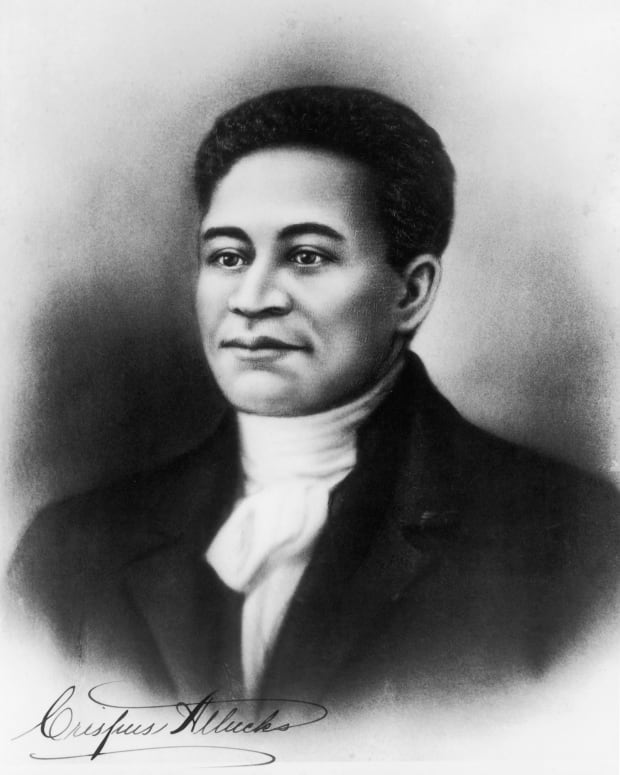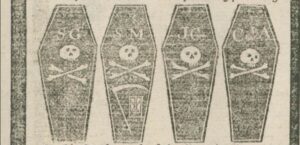Crispus Attucks

Image courtesy of Revolutionary Spaces; artist and year unknown
A black and white portrait of Crispus Attucks with his name written in the bottom left corner.
Every February, America recognizes and celebrates Black History Month. It is the birth month of two influential figures in Black History, Frederick Douglass and Abraham Lincoln, and a time to show appreciation for the incredible pride, achievements, and lives of African American people—past and present. Originally celebrated as ‘Negro History Week,’ the origins of Black History Month can be traced back to Dr. Carter G. Woodsen, founder of the Association for the Study of African American Life and History. In 1926, Dr. Woodsen established this tradition after noticing an extreme lack of African American representation across the nation’s education system. Dr. Woodsen’s contributions resulted in annual festivities and fundraisers for people of all ages to inspire knowledge and activism in the ongoing struggle for racial equity. Woodsen’s Negro History Week sought to highlight the accomplishments of notable individuals while educating Americans on the power and influence of collective Black communities throughout history.
The creation of Negro History Week, and later Black History Month, set an expectation that schools incorporate Black History into their curriculums year-round. One individual who is increasingly being taught in schools, and who has had a profound impact on African Americans’ identity is Crispus Attucks (also known as Michael Johnson).
Crispus Attucks was born around 1723 in Natick or Framingham, MA. Historic documentation indicates that he was enslaved by Deacon William Brown of Framingham . Brown placed an advertisement in the Boston Gazette on October 2, 1750 for an “Escaped Slave” by the name “Crispas.” Based on the description Brown provides of Attucks, along with descriptions from the night of his death, historians believe Attucks to have both African and Indigenous ancestry.
At the time of the Boston Gazette advertisement in 1750, two thirds of the maritime industry consisted of people of African or Indigenous decent. Life on the seas and docks provided an opportunity for people to escape enslavement and servitude, and to find paid employment, keeping them from poverty. Due to these factors, it is likely that Crispus Attucks found work as a sailor or dockworker in and around Boston Harbor. In the years leading up to the American Revolution, colonial sailors were often at the forefront of conflict with British military officials, rebelling against impressment and proclamations such as the Stamp Act (1765) and the Townshend Acts (1767). Attucks’ experiences living and working in this politically charged environment, combined with his personal identity, likely contributed to his involvement in the 1770 riot which would come to be known as the Boston Massacre.

Image originally published in the Boston Gazette March 12, 1770, and was engraved by Paul Revere.
Four black coffins feature skulls and crossbones and initials. The final coffin on the right has the initials CA (Crispus Attucks).
The Boston Massacre began on the cold and snowy evening of March 5, 1770. An argument broke out at the Customs House between the British officer on duty and a local merchant, resulting in the officer hitting the merchant with the butt of his rifle. Instantly, colonists ran to the scene and began throwing snow, rocks, and oyster shells in defense of the merchant. British reinforcements under the command of Captain Thomas Preston arrived, garnering further attacks from the colonists. Amidst the chaos, one of the soldiers fired his weapon without orders from Preston. More shots were fired, killing three colonists and leaving others wounded, including two who later died from their injuries. Crispus Attucks was the first to die that night, and is often considered the first to die in the American War for Independence.
Though little is known for certain about Crispus Attucks’ life, his death made him a martyr and an American icon in the decades and centuries that followed. During the height of the abolitionist movement in the nineteenth century, orators and activists spoke of Attucks’ sacrifice for this nation in its fight for independence, linking it to the struggle for freedom Black Americans currently faced. They reminded their audiences of the active role Crispus Attucks played in the Boston Massacre, emphasizing that Black and Indigenous people have power and agency to force collective change. This is especially poignant when drawing comparisons between the presumed patriotism and sacrifice of Attucks with the roles and societal impact of contemporary organizations such as the Massachusetts 54th and 55th Infantry Regiments.
As recently as 2020, Crispus Attucks continued to serve as a cultural touchstone in popular media. Director Spike Lee references him in his film Da 5 Bloods, drawing connections between the treatment of Black men in colonial times, to the Vietnam War, to racism and activism in the present day. Though little is known for certain about Crispus Attucks’ life, his legacy still empowers Black communities and those seeking to continue the growth and betterment of the United States.
This Black History Month and every month, Boston Harbor Islands National and State Park would like to recognize the importance of individuals like Crispus Attucks, as well as the importance of African American communities as a whole. For more information on Crispus Attucks, the Boston Massacre, and African American history in Boston, visit Revolutionary Spaces, Boston National Historical Park, and Boston African American National Historic Site. And this summer, stay tuned for Juneteenth commemorative events, hosted by Boston Harbor Islands.
References
“A Man of Many Worlds.” Revolutionary Spaces. February 10, 2021. Accessed January 07, 2022. https://www.revolutionaryspaces.org/exhibits/reflecting-attucks/reflecting-attucks-man-many-worlds/.
Higginbotham, Evelyn B., and Daryl M. Scott. “About Black History Month.” ASALH. Accessed January 07, 2022. https://asalh.org/about-us/about-black-history-month/.
“Life at Sea.” Revolutionary Spaces. January 28, 2021. Accessed January 13, 2022. https://www.revolutionaryspaces.org/exhibits/reflecting-attucks/reflecting-attucks-man-many-worlds/reflecting-attucks-life-sea/.
Lloyd, Ann W. “ART / ARCHITECTURE; Preserving Yankee History with International Ingenuity.” The New York Times, August 3, 2003. Accessed January 7, 2022.
“National Museum of African American History & Culture.” Celebrating Black History Month | National Museum of African American History and Culture. January 29, 2021. Accessed January 07, 2022. https://nmaahc.si.edu/explore/stories/celebrating-black-history-month.
Revolutionary Spaces. Revolutionary Spaces. October 20, 2020. Accessed January 13, 2022. https://www.revolutionaryspaces.org/2020/10/20/demanding-freedom/.